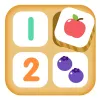Take a look inside 5 images
Todo Number Matrix: Brain teasers, logic puzzles, and mathematical reasoning for kids
Pros: Unique, highly accessible presentation of a variety of math concepts.
Cons: Without explicit instructions or clear teaching moments, some kids might feel left in the dark.
Bottom Line: Great practice tool for exploring a wide range of math concepts through unique visual representations.
Todo Number Matrix can be a fun part of any math curriculum, but it may be especially useful for kids who need a creative, visual approach to exploring math. Use the matrices as a reinforcement to challenge kids to put their logic and math skills to the test, or as an alternative way to introduce new concepts. Since there is no explicit teaching within the app, if teachers use these matrices for new concepts, they should play along and help explain the new material -- at least until kids get their bearing. Once they get the hang of it, let kids play on their own. Play gets more difficult with each level, but there's no option for creating multiple user accounts. Teachers should monitor kids so that they start at the level that's right for them, or let kids finish the whole cycle and then start over again with a new kid. Extend learning beyond the screen with hands-on math explorations in the classroom. Teachers could even construct a life-sized matrix and have kids move around within it, carrying cards to their correct slots.
In Todo Number Matrix, kids explore math concepts by figuring out the relationship between two images. Sixty-three matrices are organized by math topic: number, logic, shape, addition and subtraction, multiplication, and fractions. Each topic has multiple levels that get progressively more challenging. For example, number matrices start with figuring out that a picture of two apples should go at the intersection of two axes: the number two and a picture of an apple. A more advanced number matrix has a "shape" axis and a "6" axis, and kids must find the picture of a shape with six sides. Matrices start 2x2 and get bigger in higher levels. If kids need a hint, they can tap a question mark button to see where one picture should be placed. As kids complete levels, they collect badges on a progress chart; if they complete all 63 levels, they get a medal.
This thoughtful, unusual approach to exploring math concepts nicely taps into problem-solving capabilities. Kids need to have a good familiarity with numbers and also use critical-thinking skills to intuit the relationship between two images -- for example, that an apple and a number 2 equals two apples. This highly visual and logic-based approach to interacting with math may be especially helpful for kids who do not connect well with more traditional teaching methods. One downside is that there is no explicit guidance or instruction; instead, kids learn entirely through trial and error. Simply showing kids the solution –- which is what happens when kids tap the question mark for help –- may not be the best way to help them learn. A short how-to video or on-the-spot tutorials would be wonderful additions. Learning extensions would also help round out the experience and deepen learning potential.












